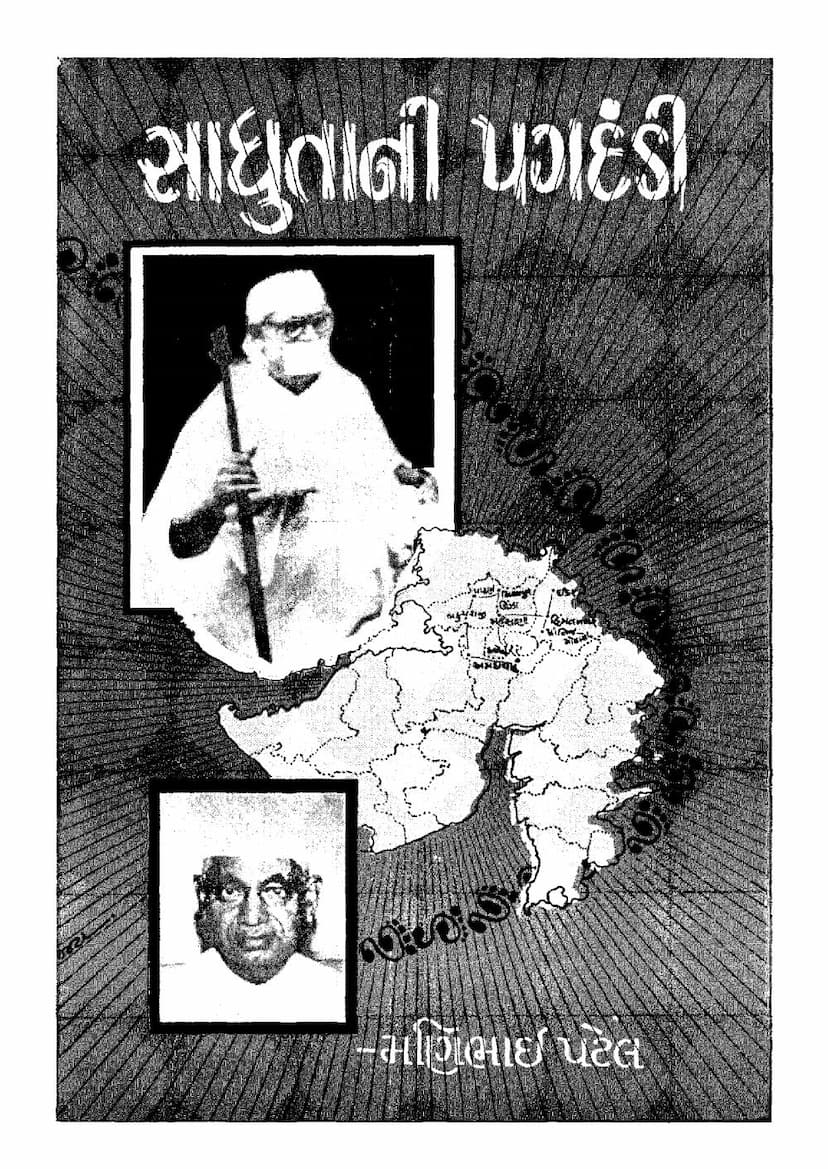Sadhuta Ni Pagdandi Part 5
Added to library: September 2, 2025

Summary
Here is a comprehensive summary of the Jain text "Sadhuta ni Pagdandi Part 5" by Manilal Patel, based on the provided pages:
Overview:
"Sadhuta ni Pagdandi Part 5" (The Path of Virtuousness, Part 5) is the fifth volume in a series documenting the spiritual journeys and public activities of Muni Shri Santbalji (often referred to as Maharajshri or Bapu). This particular volume covers the period from November 22, 1953, to November 17, 1956. The book acts as a detailed diary of his travels, interactions, and the numerous social and spiritual initiatives he undertook across Saurashtra, Kutch, and other parts of Gujarat.
Key Themes and Activities:
The core of the book revolves around Muni Shri Santbalji's unwavering commitment to spiritual discipline, social reform, and the upliftment of the common people, particularly the rural population. His activities were deeply rooted in Jain principles of non-violence, truth, detachment, and service.
-
Bhoodan Yatra and Gram Sangathan (Land Gift Movement and Village Organization): A significant portion of the narrative details Muni Shri Santbalji's extensive tours, especially in Saurashtra and Kutch, focused on promoting the Bhoodan movement initiated by Vinoba Bhave. He actively encouraged land redistribution, emphasizing the ethical responsibility of landowners to share their resources with the landless. He also tirelessly worked on organizing villages, fostering self-reliance, and addressing local issues.
-
Social Reform and Awareness: Muni Shri Santbalji was a strong advocate for social change. He addressed critical issues such as:
- Casteism and Untouchability: He actively worked to bridge the divides between different communities, urging people to see each other as fellow human beings and children of the same divine source. He participated in events that brought together people from various strata of society, including Harijans, to foster unity and break down social barriers.
- Prohibition: He consistently appealed for the abandonment of alcohol and other intoxicants, recognizing their destructive impact on individuals and society. He highlighted instances where communities took vows against alcohol and used the collected fines for child welfare and prohibition campaigns.
- Education: He emphasized the importance of education, especially for the underprivileged and women. He supported the establishment and development of educational institutions like Lok Bharti and encouraged the practical application of learning.
- Village Industries and Self-Sufficiency: He promoted the revival of traditional village industries and crafts, like the Ambar Charkha, advocating for their economic and social significance in a nation aiming for self-sufficiency.
- Hygiene and Public Health: He drew attention to basic sanitation issues, like open defecation, urging communities and leaders to address them for the well-being of the people.
-
Addressing Public Grievances and Conflicts: Muni Shri Santbalji frequently intervened in local disputes, mediating conflicts between different groups (e.g., farmers and landowners, different communities). He sought resolutions through dialogue, persuasion, and often through fasting or symbolic acts of protest (like initiating shuddhiprayog - purification rituals involving fasting). His approach was to foster understanding and reconciliation.
-
Spiritual Discourses and Moral Guidance: Throughout his travels, he delivered numerous public discourses and participated in meetings. His talks often touched upon core Jain and universal spiritual values, emphasizing the importance of ethical conduct, mental purity, detachment, compassion, and the true meaning of Dharma beyond rituals and outward appearances. He encouraged introspection and self-improvement.
-
Health and Personal Resilience: The diary entries also touch upon Muni Shri Santbalji's personal health challenges, including nose surgery and a period of illness requiring him to stay in Bhavnagar for an extended period. Despite these, he remained committed to his mission, demonstrating remarkable resilience and dedication.
-
Interactions with Prominent Figures: The text records his meetings and discussions with significant leaders of the time, including Vinoba Bhave, Mahatma Gandhi (in spirit and memory), Ravishankar Maharaj, Morarji Desai (Chief Minister of Saurashtra), U. N. Dhebar, Nanabhai Bhatt, and others involved in social and political reform. These interactions highlight the collaborative spirit of the era and Muni Shri Santbalji's recognized influence.
-
Specific Incidents and Examples: The book is rich with specific anecdotes and examples that illustrate his philosophy and methods. These range from village meetings and land distribution ceremonies to his personal fasts for social causes and his interactions with individuals from all walks of life.
Structure and Editorial Notes:
- The book is structured chronologically, detailing his daily movements, activities, and notable events.
- The editor, Manilal B. Patel, notes that while the Gujarat trip is covered, the Kutch journey is detailed in a separate booklet. He also mentions a missing period concerning the Chaturmas in Palanpur due to the unavailability of notes.
- The editor, Manu Pandit, expresses joy in publishing this fifth part, emphasizing that Muni Shri Santbalji's unique ability to shape people is evident in the many events described.
- The catalog link points to Jainqq.org, indicating the text's availability within Jain educational resources.
Overall Significance:
"Sadhuta ni Pagdandi Part 5" provides a valuable historical and spiritual account of a pivotal period in Gujarat's social and religious history. It showcases Muni Shri Santbalji's holistic approach to societal transformation, integrating spiritual principles with practical action for the betterment of humanity. The book serves as a testament to his profound influence and dedication to the Jain ideals of service and righteousness.